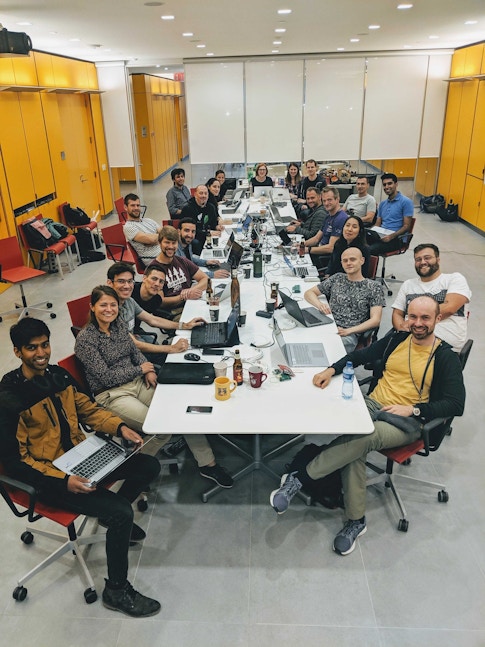Herding Cats for Effective Neuroscience Collaboration Across Continents

Large-scale collaborations in the digital era can be a difficult paradox: The existence of networking tools, such as Slack and Zoom, means that large groups can organize dozens of facets of their project and discuss them at a moment’s notice. But the pervasiveness of these tools means that time and attention have become more precious commodities than ever before. Time to sit and think about a single problem is in scarce supply for everyone from professors to graduate students. A backlog of small issues builds up as everyone is busy with their own deluge of things to do.
Given the scarcity of time and attention, we were especially excited when we were asked in May to plan a meeting of IBL postdocs, graduate students and staff for the purpose of developing new analysis code. Physical meetings, with everyone in the same room, are the perfect venue to tackle both backlogged scientific topics and high-level organizational issues within the collaboration. Being in a room with all of your collaborators means that 100 percent of attention is devoted to IBL topics 100 percent of the time, providing an invaluable opportunity to get stuff done.
The overarching goal of the IBL is to complete a brain-wide map of activity — acquired through Neuropixels probe recordings in many mice — for a single, well-defined decision-making task. In the meeting, we sought to familiarize IBL members with the systems in use across the collaboration and to develop new tools to analyze the brain-wide map data as it begins to make its way into our servers.
We structured this meeting into two separate tracks: a code camp, or tutorial, for IBL members who are learning Python and a hackathon for those who are proficient in Python. The hackers broke into small groups of three to four people and tackled topics determined in advance of the meeting, such as the development of functions for examining low-dimensional structure in neural activity. By the end of the meeting, we saw significant progress from both tracks.
After five days in New York City and more than 3,000 written lines of code for IBL analyses, we can share some key takeaways about what works and what doesn’t in organizing meetups between far-flung collaborators.
Here’s what we learned — and what we would do differently:
Getting theorists and experimentalists to work together is both crucial and easier than you’d think. A persistent notion seems to be that theorists and experimentalists in neuroscience speak different, somewhat incompatible, languages. “Neurons linearly sum their inputs” is to theory in neuroscience what the “spherical cow” is to theory in physics, and the ribbing of theorists is undeniably fun. But we found that experimentalists and theorists working together in the same room quickly generate innovative new ideas and analyses. Experimentalists bring a practical knowledge of where data comes from and how it is generated, and theorists bring a wealth of knowledge about cutting-edge analysis techniques and models for neural data.
Goal-oriented collaborative meetings need two things to succeed: direction and time. In a collaboration that meets in person both infrequently and briefly, it is tempting to turn any opportunity to work together into a disjointed mixture of roundtables, tutorials, debugging sessions and social gatherings. The obvious danger to this neither-fish-nor-fowl approach is that in the end, you make sparing progress on every topic, and the opportunity to share ideas and collaborate is wasted.
Meetings should have a well-defined scope and direction from very early in the planning stage. Attendees should know what they are working on and prepare accordingly; people don’t need to be in the same room to read papers or do background research. They should also have suggestions on how best to work together to tackle a problem. For many people in our group, the concept of collaborative coding was a fresh idea. Without suggestions on how to do so, there was a huge potential for time to be wasted duplicating efforts. Clear style and structure guidelines for written code, a solid planning methodology, and good communication systems are necessary for successful group work. We began the camp with a brief talk by core IBL programmers on all of these topics.
Participants also need time to make progress on chosen tasks. As a rule of thumb, people need 30 minutes to an hour to get up to speed on what they’re working on and to build a mental map of the challenges they face for the day. We made excellent progress during our meeting on a wide variety of problems the IBL has been working on, such as dealing with data from DeepLabCut, an object-tracking system from the Mathis groups that we use to track anatomical features, and creating functions for reducing the dimension of neural recordings.
However, the consensus among attendees was that the peppering of scientific talks, progress reports and organizational meetings throughout the camp created mental gear-changes that took away from time to spend on the things they wanted to work on.
With direction, time and, of course, adequate preparation — that is, attendees have the data they need, and the data is clean and brought into the processing pipeline — any meeting of far-flung collaborators can be turned into an opportunity to accomplish a tremendous amount in a very short time.
In a field in which scientists are spread thin between multiple projects and time-stealing obligations, in-person meetings where a topic can command their full attention can be essential for making progress. We came away from the IBL’s 2019 Code Camp convinced that more than ever, meetings like this are going to be instrumental to the success of the collaboration and, hopefully, to the field as a whole.
Berk Gercek is a Ph.D. student in the laboratory of Alexandre Pouget and an IBL researcher.


